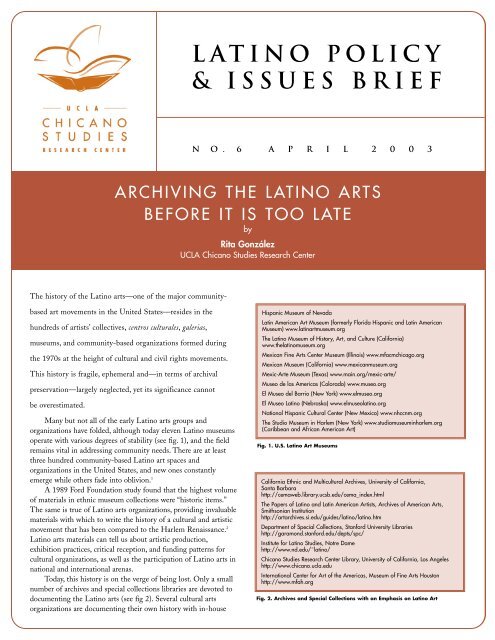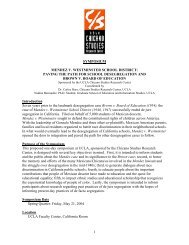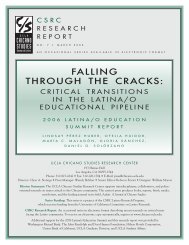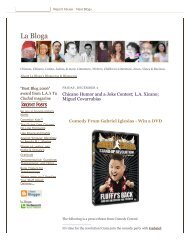Download - the UCLA Chicano Studies Research Center
Download - the UCLA Chicano Studies Research Center
Download - the UCLA Chicano Studies Research Center
Create successful ePaper yourself
Turn your PDF publications into a flip-book with our unique Google optimized e-Paper software.
Latino Policy<br />
& Issues Brief<br />
N O . 6 A P R I L 2 0 0 3<br />
ARCHIVING THE LATINO ARTS<br />
BEFORE IT IS TOO LATE<br />
by<br />
Rita González<br />
<strong>UCLA</strong> <strong>Chicano</strong> <strong>Studies</strong> <strong>Research</strong> <strong>Center</strong><br />
The history of <strong>the</strong> Latino arts—one of <strong>the</strong> major communitybased<br />
art movements in <strong>the</strong> United States—resides in <strong>the</strong><br />
hundreds of artists’ collectives, centros culturales, galerias,<br />
museums, and community-based organizations formed during<br />
<strong>the</strong> 1970s at <strong>the</strong> height of cultural and civil rights movements.<br />
This history is fragile, ephemeral and—in terms of archival<br />
preservation—largely neglected, yet its significance cannot<br />
be overestimated.<br />
Many but not all of <strong>the</strong> early Latino arts groups and<br />
organizations have folded, although today eleven Latino museums<br />
operate with various degrees of stability (see fig. 1), and <strong>the</strong> field<br />
remains vital in addressing community needs. There are at least<br />
three hundred community-based Latino art spaces and<br />
organizations in <strong>the</strong> United States, and new ones constantly<br />
emerge while o<strong>the</strong>rs fade into oblivion. 1<br />
A 1989 Ford Foundation study found that <strong>the</strong> highest volume<br />
of materials in ethnic museum collections were “historic items.”<br />
The same is true of Latino arts organizations, providing invaluable<br />
materials with which to write <strong>the</strong> history of a cultural and artistic<br />
movement that has been compared to <strong>the</strong> Harlem Renaissance. 2<br />
Latino arts materials can tell us about artistic production,<br />
exhibition practices, critical reception, and funding patterns for<br />
cultural organizations, as well as <strong>the</strong> participation of Latino arts in<br />
national and international arenas.<br />
Today, this history is on <strong>the</strong> verge of being lost. Only a small<br />
number of archives and special collections libraries are devoted to<br />
documenting <strong>the</strong> Latino arts (see fig 2). Several cultural arts<br />
organizations are documenting <strong>the</strong>ir own history with in-house<br />
Hispanic Museum of Nevada<br />
Latin American Art Museum (formerly Florida Hispanic and Latin American<br />
Museum) www.latinartmuseum.org<br />
The Latino Museum of History, Art, and Culture (California)<br />
www.<strong>the</strong>latinomuseum.org<br />
Mexican Fine Arts <strong>Center</strong> Museum (Illinois) www.mfacmchicago.org<br />
Mexican Museum (California) www.mexicanmuseum.org<br />
Mexic-Arte Museum (Texas) www.main.org/mexic-arte/<br />
Museo de las Americas (Colorado) www.museo.org<br />
El Museo del Barrio (New York) www.elmuseo.org<br />
El Museo Latino (Nebraska) www.elmuseolatino.org<br />
National Hispanic Cultural <strong>Center</strong> (New Mexico) www.nhccnm.org<br />
The Studio Museum in Harlem (New York) www.studiomuseuminharlem.org<br />
(Caribbean and African American Art)<br />
Fig. 1. U.S. Latino Art Museums<br />
California Ethnic and Multicultural Archives, University of California,<br />
Santa Barbara<br />
http://cemaweb.library.ucsb.edu/cema_index.html<br />
The Papers of Latino and Latin American Artists, Archives of American Arts,<br />
Smithsonian Institution<br />
http://artarchives.si.edu/guides/latino/latino.htm<br />
Department of Special Collections, Stanford University Libraries<br />
http://garamond.stanford.edu/depts/spc/<br />
Institute for Latino <strong>Studies</strong>, Notre Dame<br />
http://www.nd.edu/˜latino/<br />
<strong>Chicano</strong> <strong>Studies</strong> <strong>Research</strong> <strong>Center</strong> Library, University of California, Los Angeles<br />
http://www.chicano.ucla.edu<br />
International <strong>Center</strong> for Art of <strong>the</strong> Americas, Museum of Fine Arts Houston<br />
http://www.mfah.org<br />
Fig. 2. Archives and Special Collections with an Emphasis on Latino Art
<strong>UCLA</strong> CSRC<br />
California’s Growing Latino Population<br />
archival projects. These important<br />
archival efforts remain disparate and lack<br />
cohesion. In order to coordinate and<br />
focus <strong>the</strong>se efforts on a common goal—<br />
that of long-term cultural preservation—<br />
a collective vision and multi-institutional<br />
plan is imperative.<br />
The <strong>UCLA</strong> <strong>Chicano</strong> <strong>Studies</strong><br />
<strong>Research</strong> <strong>Center</strong> conducted a survey in<br />
order to assess <strong>the</strong> state of Latino arts<br />
materials archiving. Past studies have<br />
examined <strong>the</strong> infrastructure and capacity<br />
of arts organizations through case<br />
studies, 3 but little attention has been paid<br />
to how such organizations are working to<br />
preserve <strong>the</strong> history of <strong>the</strong> Latino arts.<br />
Eleven professionals were interviewed on<br />
<strong>the</strong> key issues involved in preserving a<br />
Latino cultural legacy. 4 These<br />
professionals included leading Latino<br />
scholars, archivists, librarians, curators,<br />
and arts administrators. The survey takes<br />
place at a volatile historical juncture as<br />
federal and foundation support of <strong>the</strong><br />
arts is in decline and as a massive<br />
restructuring and generational turnover is<br />
occurring in Latino arts organizations<br />
and museums. [Inset quotations are<br />
taken from responses to <strong>the</strong> survey.]<br />
ARCHIVAL PRIORITIES<br />
Collection policy within <strong>the</strong> archival<br />
community often works against <strong>the</strong><br />
preservation of ethnic and minority<br />
holdings. Current collection policy<br />
emphasizes <strong>the</strong> records of “significant,”<br />
“seminal,” or “highly illustrative”<br />
organizations or individuals. But survey<br />
respondents emphasized <strong>the</strong> critical<br />
importance of documenting short-lived,<br />
under-funded, and marginal artist<br />
collectives and organizations.<br />
“If fifty years from now all we have<br />
are records from institutions (or<br />
artist groups) that made it to <strong>the</strong><br />
ten year mark, <strong>the</strong>n we will not<br />
have understood <strong>the</strong> arts and<br />
cultural landscape.”<br />
Respondents identified “archive building”<br />
as a key priority in art institutional<br />
contexts in order to support collection<br />
and exhibition efforts, but also to<br />
encourage scholarly research and training<br />
for educators and organizers.<br />
CHICANO CINEMA RECOVERY PROJECT<br />
A multi-year initiative in collaboration with <strong>the</strong> <strong>UCLA</strong> Film and Television Archive to identify, preserve, and make<br />
accessible <strong>the</strong> independent productions of <strong>Chicano</strong> and Latino filmmakers.<br />
Funders: Ahmanson, Ford, and Rockefeller Foundations, and UC MEXUS<br />
CHRIS STRACHWITZ FRONTERA COLLECTION<br />
The digital preservation of <strong>the</strong> Arhoolie Frontera Collection which contains 30,000 Spanish language<br />
phonographic recordings made in <strong>the</strong> United States from 1904–1957.<br />
Funder: Los Tigres del Norte Foundation<br />
A VER: REVISIONING ART HISTORY<br />
A major research project and monograph series on <strong>the</strong> cultural, aes<strong>the</strong>tic, and historical contributions of <strong>Chicano</strong>,<br />
Puerto Rican, Cuban, and o<strong>the</strong>r U.S. Latino artists.<br />
Start up funds from UC MEXUS<br />
VISIONES ARCHIVAL PROJECT<br />
A project to process <strong>the</strong> document collection of <strong>the</strong> National Association of Latino Arts and Culture (NALAC), <strong>the</strong><br />
Visiones documentary series, and <strong>the</strong> institutional papers of NALAC affiliates.<br />
Start up funds from NALAC<br />
Fig. 3. <strong>Chicano</strong> <strong>Studies</strong> <strong>Research</strong> <strong>Center</strong>: Arts Projects<br />
INSTITUTIONAL FRAGILITIES<br />
Latino arts organizations and ethnic<br />
museums, faced with severe budget<br />
shortages, often cannot afford <strong>the</strong> costs<br />
of documenting <strong>the</strong>ir own history.<br />
“Many organizations would like to<br />
institute a formal archive or<br />
designate a recipient of archival<br />
materials, however, <strong>the</strong>y refrain<br />
from doing so due to financial<br />
constraints and negative<br />
experiences in collaborative<br />
ventures.”<br />
Ethnic museums, faced with<br />
tightening budgets, are influenced by<br />
trustees and o<strong>the</strong>r economic factors to<br />
internationalize <strong>the</strong>ir profile. In <strong>the</strong><br />
process, some museums have shifted<br />
from <strong>the</strong>ir original mission of supporting<br />
community-based art and exhibitions.<br />
“There exists a division between<br />
<strong>the</strong> progressive Latino scholars<br />
working on one side to preserve <strong>the</strong><br />
community record, while on <strong>the</strong><br />
o<strong>the</strong>r side, arts administrators and<br />
curatorial staffs have o<strong>the</strong>r<br />
priorities.”<br />
Given <strong>the</strong> personal character of arts<br />
organizations, key documents remain in<br />
<strong>the</strong> possession of individuals, oftentimes<br />
stored in dangerous, non-archival<br />
conditions. Just as <strong>the</strong> transition across<br />
generations requires a careful negotiation,<br />
so to does <strong>the</strong> documentation of <strong>the</strong><br />
outgoing director’s experience. As one<br />
scholar explained, “when <strong>the</strong> director<br />
goes, <strong>the</strong> institutional history goes.”<br />
As one arts professional noted,<br />
“<strong>the</strong>re is a fragility on <strong>the</strong> institutional<br />
level”—in large part because <strong>the</strong>se<br />
cultural and art spaces have survived due<br />
to individuals, but also because <strong>the</strong>y have<br />
often never been able to develop beyond<br />
a “mom and pop” organizational<br />
structure.<br />
RECORDS MANAGEMENT<br />
Many arts organizations and individual<br />
holders of arts related materials do not<br />
recognize <strong>the</strong> historical value of what <strong>the</strong>y<br />
possess. Survey participants identified<br />
organizations that fail to archive <strong>the</strong>ir own<br />
exhibition catalogues, newsletters, fliers,<br />
and o<strong>the</strong>r ephemera related to <strong>the</strong>ir<br />
achievements and activities. Fur<strong>the</strong>rmore,<br />
museums and organizations are often<br />
hesitant to share <strong>the</strong> “nitty-gritty<br />
information” for <strong>the</strong>y fail to see <strong>the</strong><br />
importance of <strong>the</strong>ir “excess paperwork.”<br />
This material is <strong>the</strong>n relegated to<br />
improper storage spaces or even discarded.<br />
“Organizations need to know <strong>the</strong><br />
way of going about archiving<br />
materials, what kind of things<br />
should be saved. Organizations<br />
need to be given a process so <strong>the</strong>y<br />
know where to start.”<br />
A librarian actively involved in <strong>the</strong><br />
collection of Latino arts materials<br />
commented that “records management” is<br />
<strong>the</strong> key component needed to facilitate
POLICY BRIEF APRIL 2003<br />
<strong>the</strong> archival process. A streamlined<br />
management of records makes <strong>the</strong><br />
organizations more autonomous and<br />
enhances <strong>the</strong> smoothness of a transfer of<br />
records, if and when <strong>the</strong> organization<br />
decides to deposit <strong>the</strong>ir papers with a<br />
repository.<br />
PARTNERSHIPS<br />
Survey participants emphasized <strong>the</strong> need to<br />
facilitate stronger connections between arts<br />
organizations and “appropriate collecting<br />
entities.” Archivists in particular pointed to<br />
<strong>the</strong> importance of maintaining connections<br />
with individuals and organizations that<br />
have donated materials.<br />
“Documentation involves a<br />
partnership between those who<br />
generate historically valuable records<br />
and those who collect <strong>the</strong>m and make<br />
<strong>the</strong>m accessible for use.”<br />
In <strong>the</strong> end, long-term relationships between<br />
institutions and materials holders must be<br />
based on “trust, clarification, and <strong>the</strong> guarantee<br />
of access to <strong>the</strong>ir archival materials.”<br />
RECOMMENDATIONS<br />
In order to preserve materials related to <strong>the</strong><br />
Latino arts before it is too late, collecting<br />
institutions must begin coordinating <strong>the</strong>ir<br />
efforts in partnership with scholars, arts<br />
organizations, and artist groups. The task is<br />
both too large and too time sensitive for a<br />
single collecting institution. Instead, efforts<br />
are required on a number of fronts.<br />
• Conduct a nationwide, comprehensive<br />
survey of existing resources, collections and<br />
initiatives; make this information available<br />
through a web site.<br />
• Increase community organizations’<br />
awareness and knowledge of archival<br />
practices, including workshops on records<br />
management, and listings of archives with<br />
related collecting interests.<br />
• Expand a national level of coordination<br />
among artists, archival resources, and<br />
institutions through a national coordinating<br />
council to oversee <strong>the</strong> preservation of Latino<br />
arts resources.<br />
• Formulate and disseminate a multiinstitutional<br />
collection development policy<br />
on Latino arts materials.<br />
• Increase <strong>the</strong> acquisition of and access to<br />
material through <strong>the</strong> hiring of bilingual area<br />
specialists with archival expertise and<br />
through <strong>the</strong> digitizing of collections.<br />
REFERENCES<br />
Bustamante, Antonio Ríos, and Christine Marin. 1998.<br />
Latinos in Museums: A Heritage Reclaimed. Malabar,<br />
Florida: Krieger Publishing Company.<br />
Davalos, Karen Mary. 2001. Exhibiting Mestizaje:<br />
Mexican (American) Museums in <strong>the</strong> Diaspora.<br />
Albuquerque: University of New Mexico Press.<br />
Davila, Arlene. 1997. Sponsored Identities: Cultural Politics<br />
in Puerto Rico. Philadelphia: Temple University Press.<br />
Gaspar de Alba, Alicia. 1998. <strong>Chicano</strong> Art<br />
Inside/Outside <strong>the</strong> Master’s House: Cultural Politics and <strong>the</strong><br />
CARA Exhibition. Austin, Texas: University of Texas Press.<br />
Güereña, Salvador. nd. “Archives and Manuscripts:<br />
Historical Antecedents to Contemporary <strong>Chicano</strong><br />
Collections.” http://cemaweb.library.ucsb.edu/arcman.html<br />
McCoy, Garnett. 1997. Reading Records: A <strong>Research</strong>er’s<br />
Guide to <strong>the</strong> Archives of American Art. Washington<br />
D.C.: Archives of American Art, Smithsonian Institution.<br />
Yount, Sylvia. 2001. “Braving (and Bridging) <strong>the</strong> Great<br />
Divide: The Academy and <strong>the</strong> Museum.” American Art<br />
15, no. 3 (Fall): 2–7.<br />
Zamora, Herlinda. 2002. “Identity and Community: A<br />
Look at Four Latino Museums.” Museum News<br />
(May/June): 37–41.<br />
NOTES<br />
The author would like to thank <strong>the</strong> survey participants for<br />
sharing <strong>the</strong>ir time and expertise as well as <strong>the</strong> following<br />
CSRC staff for <strong>the</strong>ir comments: Alicia Gaspar de Alba<br />
(Associate Director), Alma Ortega (Librarian), and<br />
Marisol Ramos-Lum (Archivist).<br />
1. The number is based on <strong>the</strong> National Association of<br />
Latino Arts and Culture (NALAC) membership roster.<br />
2. Following <strong>the</strong> Archives of American Art’s definition,<br />
archival art materials would include “letters, notebooks,<br />
photographs, diaries of artists and <strong>the</strong>ir descendants; <strong>the</strong><br />
unpublished notes of art historians; <strong>the</strong> correspondence of<br />
art dealers; interviews with living artists; and <strong>the</strong> records<br />
of major galleries and arts organizations.” (McCoy<br />
1997; see also Güereña n.d., and Davalos 2001)<br />
3. See Bustamante and Marin 1998; Davalos 2001;<br />
Davila 1997; and Gaspar de Alba 1998.<br />
4. Richard Chabran (Communities for Virtual <strong>Research</strong>,<br />
Ernesto Galarza Applied <strong>Research</strong> <strong>Center</strong>, UC-<br />
Riverside), Karen Mary Davalos (Loyola Marymount<br />
University), Arlene Davila (New York University),<br />
Salvador Güereña (California Ethnic and Multicultural<br />
Archives, UC-Santa Barbara), Maria Lopez de León<br />
(National Association of Latino Arts and Culture<br />
[NALAC]), Magdalena Mieri (<strong>Center</strong> for Latino<br />
Initiatives, Smithsonian), Sandra Perez (Association of<br />
Hispanic Artists), Mari Carmen Ramirez (International<br />
<strong>Center</strong> for Art of <strong>the</strong> Americas, Museum of Fine Arts,<br />
Houston), Pedro Rodriguez (Founding Director, NALAC),<br />
Tere Romo (Movimiento de Arte y Cultura Latino<br />
Americana [MACLA]), and Roberto Trujillo (Department<br />
of Special Collections, Stanford University Libraries).<br />
AUTHOR<br />
FUNDER<br />
Rita González is Arts Project Coordinator at <strong>the</strong> <strong>UCLA</strong> <strong>Chicano</strong> <strong>Studies</strong> <strong>Research</strong> <strong>Center</strong>. She is also a<br />
video maker, independent curator, and writer. Her co-curated collaboration Mexperimental Cinema was <strong>the</strong> first<br />
survey of experimental and avant-garde work from Mexico. She is currently a doctoral candidate in <strong>the</strong><br />
Department of Film, Television and Digital Media at <strong>UCLA</strong>.<br />
<strong>Research</strong> for this report was made possible in part through funding from <strong>the</strong> National Association of<br />
Latino Arts and Culture (NALAC) and <strong>the</strong> University of California Institute for Mexico and <strong>the</strong> United<br />
States (UC MEXUS).
ARCHIVING THE LATINO ARTS BEFORE<br />
IT IS TOO LATE<br />
The history of Latino art will be lost unless immediate and coordinated<br />
efforts are made to preserve materials from hundreds of communitybased<br />
arts organizations.<br />
FOR MORE INFORMATION, CONTACT:<br />
<strong>UCLA</strong> <strong>Chicano</strong> <strong>Studies</strong> <strong>Research</strong> <strong>Center</strong><br />
193 Haines Hall<br />
Los Angeles, CA 90095-1544<br />
Phone: 310-825-2642<br />
Fax: 310-206-1784<br />
E-Mail: aztlan@csrc.ucla.edu<br />
MISSION STATEMENT<br />
The <strong>UCLA</strong> <strong>Chicano</strong> <strong>Studies</strong> <strong>Research</strong> <strong>Center</strong> supports<br />
interdisciplinary, collaborative, and policy-oriented research on issues<br />
critical to <strong>the</strong> <strong>Chicano</strong> community. The center’s publication unit<br />
disseminates books, working papers, and <strong>the</strong> peer-reviewed Aztlán:<br />
A Journal of <strong>Chicano</strong> <strong>Studies</strong>.<br />
The center’s books and journals are sold at<br />
www.chicano.ucla.edu<br />
Latino Policy & Issues Brief. An ongoing series<br />
offering <strong>the</strong> late st research on critical issues facing<br />
<strong>the</strong> Latino community.<br />
Editor: Chon A. Noriega<br />
Publications Coordinator: Wendy Belcher<br />
<strong>Research</strong> Assistant: Alison Hoffman<br />
<strong>UCLA</strong> CHICANO STUDIES RESEARCH CENTER<br />
193 HAINES HALL<br />
LOS ANGELES, CA 90095-1544<br />
CG37







